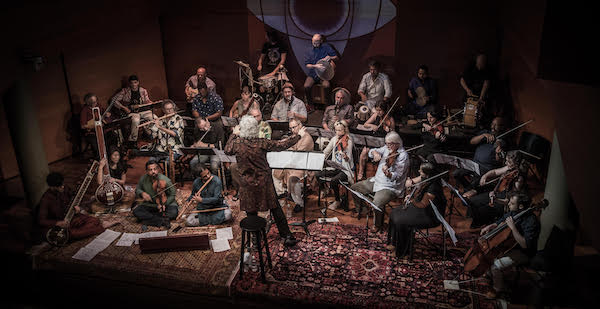Jun 3, 2025 11:25 AM
In Memoriam: Al Foster, 1943–2025
Al Foster, a drummer regarded for his fluency across the bebop, post-bop and funk/fusion lineages of jazz, died May 28…

Adam Rudolph conducts the Go: Organic Orchestra at New York’s Rubin Museum of Art.
(Photo: Adrien H. Tillman)Bandleader and percussionist Adam Rudolph sees himself as an inventor, rather than a composer. Composers typically generate written music using a pencil or a music notation program, but he does more than that.
He creates new practices for making music.
“As an artist, I’ve always been interested in the creative process itself,” Rudolph said. “I believe that when you create a new process that the art you generate will be prototypical. Prototypical art means that the power of the individual voice actually takes the listener to a more universal experience.”
Rudolph has spent nearly five decades developing his individual voice. As a hand percussionist, he never fit neatly into the codified systems of European-derived classical music, but he did move easily through many other traditions with roots in oral expression. He spent much of his career traveling the globe and performing alongside creative musicians as diverse as multi-instrumentalist Yusef Lateef, trumpeters Don Cherry and Wadada Leo Smith, saxophonist Pharoah Sanders, violinist L. Shankar, composer Philip Glass and pianist Omar Sosa. Along the way, Rudolph was working out his own ideas about what this “universal” listener experience might be—and how it might be achieved.
His latest recording, Ragmala: A Garland Of Ragas (Meta), stands as a testament to his sui generis creative process. The two-disc set—a gorgeously complex tapestry of sounds, hues and sensations—features Rudolph’s Go: Organic Orchestra, a 30-piece string-based improvisational ensemble, in a sublime pairing with the Brooklyn Raga Massive, a collective devoted to creative expressions of Indian classical music. On any of the album’s 20 tracks, one might hear a droning tanpura, a free-wailing trumpet, a string quartet, guttural throat singing,or a riffing rock guitar—all speaking to each other.
To understand why these inventive, culturally heterogeneous compositions work, it helps to dig into how Rudolph goes about creating them. His compositional approach stands on three pillars: his own intervallic matrices and cosmographs that he uses to establish the harmonic color of a piece; “ostinatos of circularity,” or polyrhythmic combinations that drive the musical motion; and a self-created system of conductor’s signals that lead the improvisation.
“I conduct the orchestra in the moment ... so that the score is rendered spontaneously with the musicians,” Rudolph said. “How the score comes together is never going to be the same twice.”
The score, as such, is minimal, which is why he appreciated the skills that Raga Massive brought to his work. Having trained in an oral tradition, members of the group picked up Rudolph’s compositional process quickly. The cornerstone of Indian classical improvisation is the raga—an established melody, rhythmic phrase and mood all in one, Rudolph explained, and “a ragmala is where advanced players improvise on more than one raga in their performances.”
For Rudolph, who’s spent two decades studying Hindustani tabla (North Indian drumming), the collaboration with musicians who understood this kind of spontaneous composition “made a lot of sense.”
Jazz drummer Sameer Gupta, a tabla player with the collective, agreed. “Adam is definitely hip to Indian classical music,” he said. “He understands the beauty and expansiveness of those ancient melodies.”
Rudolph’s process also aligns with the collective’s mission of creating raga-inspired music, even if the edges that define Indian classical music get a little blurry.
“I think that Adam is stretching for something beyond the sphere of what we can even hope to hold some sort of standard to,” Gupta opined. “He’s bringing together so many different streams, everything from West African music to Indian classical music to contemporary improvisational music to orchestral music—it ceases to be any one thing.”
Not any one thing, perhaps, but no idle gambit, either. “When you listen to John Coltrane or Miles Davis or Yusef Lateef, you’re hearing very singular, very powerful, very individualistic voices,” Rudolph asserted. “Because their voices are so individualistic, they actually tap into a universal feeling that connects us. That’s the humanity of it.” DB

Foster was truly a drummer to the stars, including Miles Davis, Sonny Rollins and Joe Henderson.
Jun 3, 2025 11:25 AM
Al Foster, a drummer regarded for his fluency across the bebop, post-bop and funk/fusion lineages of jazz, died May 28…

“Branford’s playing has steadily improved,” says younger brother Wynton Marsalis. “He’s just gotten more and more serious.”
May 20, 2025 11:58 AM
Branford Marsalis was on the road again. Coffee cup in hand, the saxophonist — sporting a gray hoodie and a look of…

“What did I want more of when I was this age?” Sasha Berliner asks when she’s in her teaching mode.
May 13, 2025 12:39 PM
Part of the jazz vibraphone conversation since her late teens, Sasha Berliner has long come across as a fully formed…

Roscoe Mitchell will receive a Lifetime Achievement award at this year’s Vision Festival.
May 27, 2025 6:21 PM
Arts for Art has announced the full lineup for the 2025 Vision Festival, which will run June 2–7 at Roulette…

Benny Benack III and his quartet took the Midwest Jazz Collective’s route for a test run this spring.
Jun 3, 2025 10:31 AM
The time and labor required to tour is, for many musicians, daunting at best and prohibitive at worst. It’s hardly…